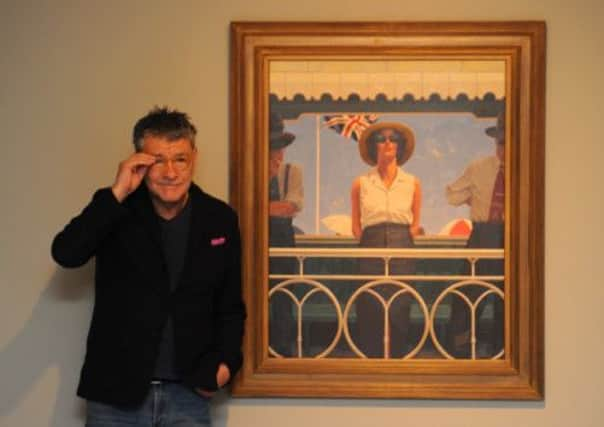Jack Vettriano: ‘I owe success to SoS critic’


W Gordon Smith gave the artist his first ever media exposure after visiting his flat in Edinburgh to look at his work, and remained a staunch supporter when Vettriano came under fire from other critics.
Smith singled out The Singing Butler for praise when he saw more than 30 of Vettriano’s paintings and the work was reproduced in Scotland on Sunday when the first interview with the artist appeared in July 1991.
Advertisement
Hide AdVettriano said he had waited for 20 years to get the chance to pay proper tribute to the late journalist, author and playwright – saying his interest had almost single-handedly launched him on to the Scottish art scene.


Smith was asked by the artist to write the introduction to his first major solo exhibition – Tales of Love and Other Stories – at the Edinburgh Gallery in 1992.
The introduction has been reproduced in full for Vettriano’s guide to his retrospective at Kelvingrove Art Gallery and Museum in Glasgow, which opened yesterday and is tipped to be one of the most successful exhibitions in its history.
In 1994, Smith edited a lavish book of Vettriano’s work, which featured poems, short stories and extracts of novels inspired by his paintings by the likes of Alasdair Gray, AL Kennedy, Ian Hamilton Finlay, Joan Lingard and Norman MacCaig.
Smith – who died two years later – was a highly successful television and radio producer, playwright and critic who wrote for Scotland on Sunday late in his career after stints with the Observer and the Edinburgh Evening News.
He was widely credited with introducing arts programmes to BBC Scotland on both radio and television. He published books about the painters David Donaldson, Sir Robin Philipson and Sir William Gillies.
Advertisement
Hide AdVettriano said: “The whole exhibition at Kelvingrove is dedicated to W Gordon Smith, who was the art critic at Scotland on Sunday when I first started out.
“He was astonishingly helpful to me and I’ve waited patiently for a public opportunity to pay tribute to him. His generosity of spirit kept me going when some critics were being absolutely horrific to me.
Advertisement
Hide Ad“When some of the critics got on my case and started to call my work soft porn, that’s when he really came into his own with me. He rang me up and said ‘whatever you do, don’t take it seriously’.
“I was suffering quite badly at the time. Success is wonderful – that’s easy to deal with. Criticism is not.
“If Gordon couldn’t say something good about an artist he wouldn’t say something bad.
“I’ve never met anyone with such grace, spirit and goodwill. He also knew just about everybody in the art world in Scotland. He was a colossus.”
Born Jack Hoggan in 1951 in Methil, Fife, he later took his mother’s maiden name and had his first success as an artist in 1989, when he had two paintings accepted for the annual exhibition at the Royal Scottish Academy in Edinburgh. But he was still a relative unknown when Smith tracked him down at his flat in the city.
Vettriano added: “I’ll never forget the day he phoned me, right out of the blue, having got my number from somewhere and said: ‘I hear you’re a painter, can I come and see you?’
Advertisement
Hide Ad“He didn’t talk about an interview or anything like that. He came and looked at my work and said: ‘This is astonishing. It’s more like the Glasgow Boys than Edinburgh’.
“He rang me up and told me to buy the paper as he had done a big piece about me. He virtually single-handedly launched me on to the art scene.”
Advertisement
Hide AdIn that 1991 piece, Smith said of Vettriano: “His people are set in a timeless limbo, caught up in dramas of their own devising, whipped up by winds on sunny beaches, cast in sinister racecourse shadows, threatened by the consequences of extravagant behaviour, paying prices for carnal follies. He is a teller of mysterious tales, an eavesdropper, a voyeur with his own keyhole on life.”
Vettriano, who left school at 16 to become an apprentice mining engineer, said: “When he came to my studio at my flat on Castle Terrace I was really nervous as I had never spoken to a journalist or been interviewed before.
“I had my fingers crossed behind my back hoping he would like my work. He looked at me and said: ‘Where have you been?’
“We had a chat and at the end of the interview he said: ‘I’m going to write about you and I’d like to take a photograph of that’. He was pointing at The Singing Butler. His article was on a full page in Scotland on Sunday.
“You used to be able to buy the paper on the steps behind the office. I stood outside and waited until I got it, carefully folded it, jumped into a cab, took it home, lit a cigarette and poured a glass of wine. It was like a ritual for me.
“I sat down and looked at it and just thought to myself: ‘Oh my God.’ I was interviewed on radio twice the following week.”
Advertisement
Hide AdSmith’s essay on Vettriano, which is reproduced in the Kelvingrove exhibition guide, said: “Once in a month of Sundays, out of nowhere – or that artistic nowhere which was the Fife coalfields – an artist emerges, arrives on the scene ready-made, knowing how and what he wants to paint, and already painting like a dream.”